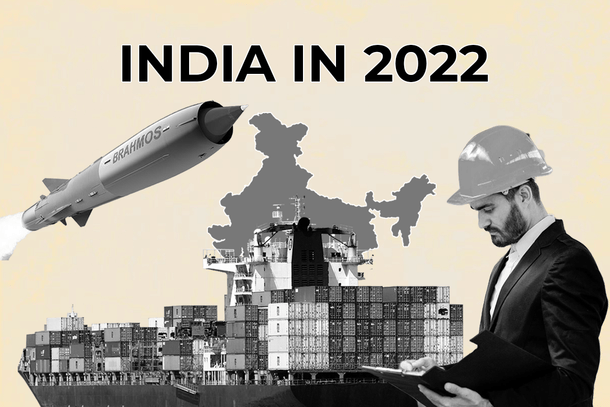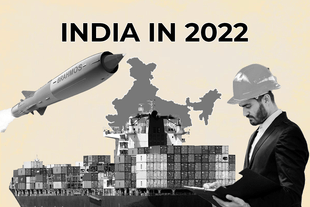Commentary
2022: The Year That Strengthened Global Optimism About India
Pratim Ranjan Bose
Dec 22, 2022, 05:08 PM | Updated 05:08 PM IST
Save & read from anywhere!
Bookmark stories for easy access on any device or the Swarajya app.


The year-end newspaper headlines are a pleasure to the eyes.
Manufacturing stocks are back in the limelight. Capital expenditure is rising, ignoring the global gloom. Mobile phones and military hardware are India’s new export heroes. Indian start-ups are earning global recognition and, even our oil refiners started earning better margins.
The horizon is not free from concerns. But, the migration of investments from China to India is now looking real. Apple’s increased outsourcing plan from India lifted the morale.
And, last but not the least, the sustained Covid fiasco in China, has finally proved that despite all limitations, India might have managed the pandemic situation better.
This is a sea change from the gloomy days of the first phase of the lockdown in 2020, when the quarterly GDP contracted by 24 per cent year-on-year.
This is also a sea change from the apprehension and cynicism, expressed by the elites, at the beginning of this year when the Ukraine crisis broke out.
Cynicism comes naturally to the Indian elite, who draw their inspiration from the same West that once laughed at India’s space aspirations (and projected the country as a land of elephants, sadhus and rope tricks) and puts India’s latest democracy rankings below Hong Kong or just above Russia!
The West tried the same things with China before Beijing turned the table on them. Today when China changes reporting norms of Covid death, no one would try to attribute some imaginary number (of deaths) to them, as they just did to India.
To some extent, that process has already started. The architect of modern India, P V Narasimha Rao, got little appreciation during his years in power and even after that.
Atal Bihari Vajpayee drew some attention for his highway modernization project but, his global vision and thrust to unleash the private sector enterprise remained less discussed.
By that standard, Prime Minister Narendra Modi is the luckiest to see the elites swallowing their words so soon. This is partly due to the strong conviction of the government, the magnitude of the change in such a short period and, partly due to the democratization of media, which again is an ongoing process.
The proliferation of social media has been a boon. Gone are the days when a few media barons and elite journalists had set the mood of the nation. Today, every piece of information is subjected to heavy scrutiny on Twitter.
Obviously, there are flipsides to the emerging scenario. But the positives far outnumber that.
The dramatic widening of the opportunity and speed of public debate is helping stakeholders, including policymakers, to do course corrections quicker than ever.
During the lockdown, traditional media focused on the ‘plight of migrant labourers’ narrative. But social media offered more layered information.
States like Andhra Pradesh and Odisha ensured a smooth transfer of people. Bengali jewellery workers in Mumbai wanted flight connectivity. They had money to pay for tickets.
A quick response has definitely helped negate cynicism. But the bulk of the credit for the newfound optimism goes to the government.
As early as in 2020, the Prime Minister willy-nilly alerted the nation that the pandemic is going to create a once-in-a-lifetime opportunity for the country.
This was followed by the launch of production-linked incentive schemes (PLI) to attract large investments in select areas. PLI aims to create global-scale capacities in a time-bound manner.
The PLI scheme is still in its early years. However, everything is not hunky dory about it. There are gaps between promise and reality, particularly in terms of job creation, which will remain a worry due to a variety of factors including technology transition.
There are also views that instead of supporting a select few producers under PLI, the government should take a more classical view to remove irritants for manufacturing in general and strengthen the small and medium enterprises (SME) sector.
Such critics treat India as a unitary economy, which it is not.
West Bengal has the largest share of SMEs in the country. The total number of factories in the state is similar to that of Gujarat. But when it comes to the contribution of industry to the gross state domestic product, Bengal is nowhere.
Quality investments in the automobile sector paved way for the rise of quality ancillaries. This is vastly different from the general mass of SMEs, born out of a socialistic legacy, who lack innovation, thrived on the reservation in government tenders and earned profit delta on tax evasion.
Let's face it, there are reasons why manufacturing didn’t grow thirty years after liberalization and why it is restricted to limited geographies. What is possible in economic theories is often difficult from a political-economic perspective.
India needed a quick and unconventional thrust to achieve the twin objectives of optimizing global opportunities and breaking the political economy of imports.
From this count, Modi’s PLI is as major a change as the creation of a few (Special Economic Zones) SEZs by Deng Xiaoping in China in the 1980s.
Apparently, it is helping. From the North and the West, India’s manufacturing map had spread to South post-liberalisation.
The initial burst of big-ticket investments indeed went to the same destinations in the North, West and South. But a look at Odisha’s new industrial policies will tell you, that the map will soon expand to the East.
The decline of Kashmir and extra emphasis on manufacturing in the news space are two greatest things that has happened to India in recent years. We needed to break the stereotypes to give optimism a chance.
This is merely a transition phase. The making of as complex an economy is not mathematics. Like the stock index, there will be many twists and turns in the short and medium run. But as long as we are optimistic about it and determined to score, there will be solutions.
The year 2022 strengthened global optimism about India. It's precious.





